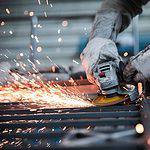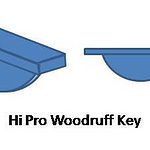Today we will learn about rolling process types, working, terminology and application with its diagram. Rolling is a major manufacturing process of sheets and other cross sections of large length like I beam, railroads etc. It is one of a metal forming process in which the metal work piece is compressed between a set of rolls where it reduces its cross section area and increases its length. This process gives high production rate, surface finish and grain structure which make it a most suitable metal forming process for large length same cross section work pieces but high set up cost of rolling machine makes it as an alternative process.
Rolling Process:
Terminology:
The most common terminologies used in rolling process are given below.
Ingot:
It is casted structure with porosity and blowholes. Ignot is same as used in forging. This ingot is rolled out at hot temperature of about 1200 degree centigrade into blooms. This ingot may have any size according to the rolling requirement.
Blooms:
It is first rolled product making by rolling ingot at high temperature. It has cross section area more than or equal to 230 square centimeters. This bloom is further rolled to make I section, billet, channel, railroad etc.
Slab:
Slab is made by hot rolling of ingot. It has cross section area greater than or equal to 100 centimeters square and its width is greater than or equal to three times of its thickness. Slabs are used to form plates, sheets, strips etc.
Billets:
Billets are product of hot rolling of blooms. It has greater than or equal to 40 square centimeters cross section area. Billets are used to roll into pipes, bars, wire etc.
Plate:
Plate is product of further rolling of slab. It has greater than 6 mm thickness.
Sheet:
Sheet has less than 6 mm thickness and width greater than 60 cm.
Strip:
Strip is same as sheet but have width less than 60 cm.
Working Principle:
Rolling works on same as any other metal forming process. When a compressive force applied by a set of rolls on ingot or any other product like blooms or billets, plastic deformation takes place which decrease its cross section area and convert it into required shape. These rolls are designed according to the final product requirement. They are cylindrical in shape and fitted with the die of the required shape which to be rolled on blooms or billets. Rolling can be done in both hot and cold way.
Hot rolling is done at above recrystallization temperature. It is used to large deformation. It gives residual stresses free product but gives poor dimension accuracy and surface finish due to scale formation.
Cold rolling is another method witch is done at below recrystallization temperature. It is done to get final product. This process gives high mechanical strength, dimension accuracy and surface finish.
Types of Rolling:
Rolling can be classified into following ways.
Thread or Gear Rolling:
This process is used to cut threads or gear on cylindrical blank. In this process threaded dies are fitted on cylindrical rollers of rolling machine. This threaded roller pressed against cylindrical blank and roll against the faces which displace the material and form threads on cylindrical blank. This process gives high strength and surface finish and used to mass production of screw, bolts etc.
Shape Rolling:
Shape rolling is used to cut various shapes on metal work piece. It does not involve appreciable change in thickness. It is used to rolled I section, T section, railroads etc.
Ring Rolling:
Ring rolling is an another method of rolling which is used to rolled rings of large bearings, turbines etc. In this process, two rollers (Main Roller and Idler Roller) are arranged as shown in figure and rotate in same direction to each other. The ring rotates due to rotation of roller and the rollers start move closer to each other. This will increase the diameter of rings. A pair of edge rollers is used to maintain the height of ring which does not allow to metal flow in the direction of height. This process gives high accuracy and material finish.
Tube Piercing:
It is another rolling process in which a stationary mandrel is used at the center of tube and cavity form due to tensile stress in a cylindrical rod when subjected to external compressive stress. In this process two opposite rolls are rotate in opposite direction which compress the tube and feed it against mandrel which create hollow cavity in it. This process is used to making seamless hollow tubes of thick wall.
Skew Rolling:
Skew rolling is used to make balls of ball bearing. In this process round bar or wire is fed directly into special designed rollers which continuously form spherical balls by rolling action. This process is used for mass production of small size spherical balls.
Transverse Rolling:
Transverse rolling is another type of rolling which is used to make tapper shaft, leaf springs etc. in this process both rollers are rotate in same direction and the bar is fed transversely. The rolls are fitted with special kind of tapped section which used to form tapped cavity of cylindrical work piece.
Application:
- Rolling is used for making hollow seamless tubes, rods etc.
- Large length cross sections are produced by rolling process.
- It is use for mass production of threaded parts like screw, bolts etc.
- Gears can be cut on gear blank by rolling process.
- Construction material, roofing panels, partition beams, railroads, etc. are rolling product.
- It is used in automotive industries for manufacture various parts.
- Rings of turbines, bearing and other machines are rolling product.
- Steel sheets, plates are made by rolling process.
This is all about rolling process types, working, terminology and application. If you have any query regarding this article, ask by commenting. If you like this article, don’t forget to share it with your friends. Subscribe our website for more interesting articles. Thanks for reading it.









